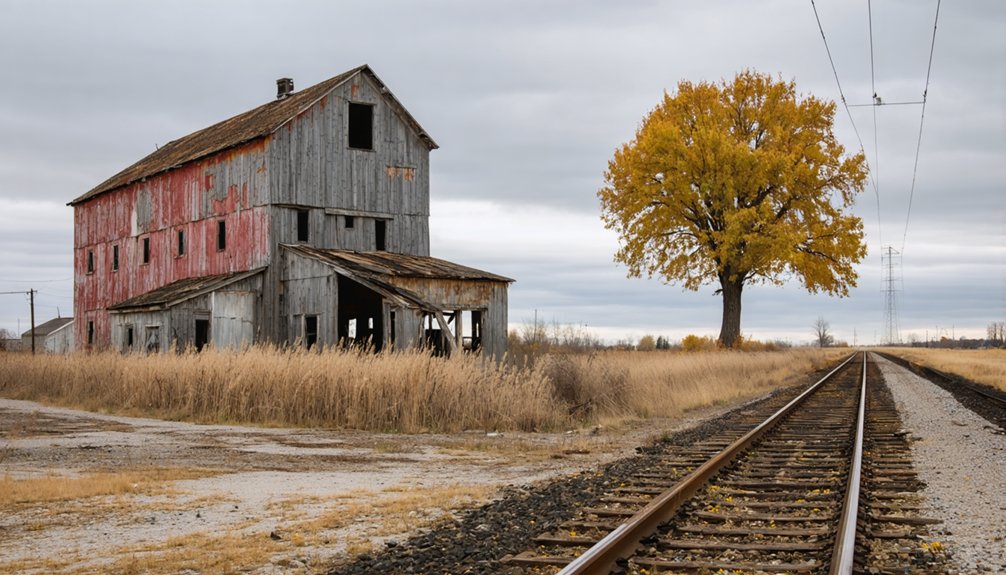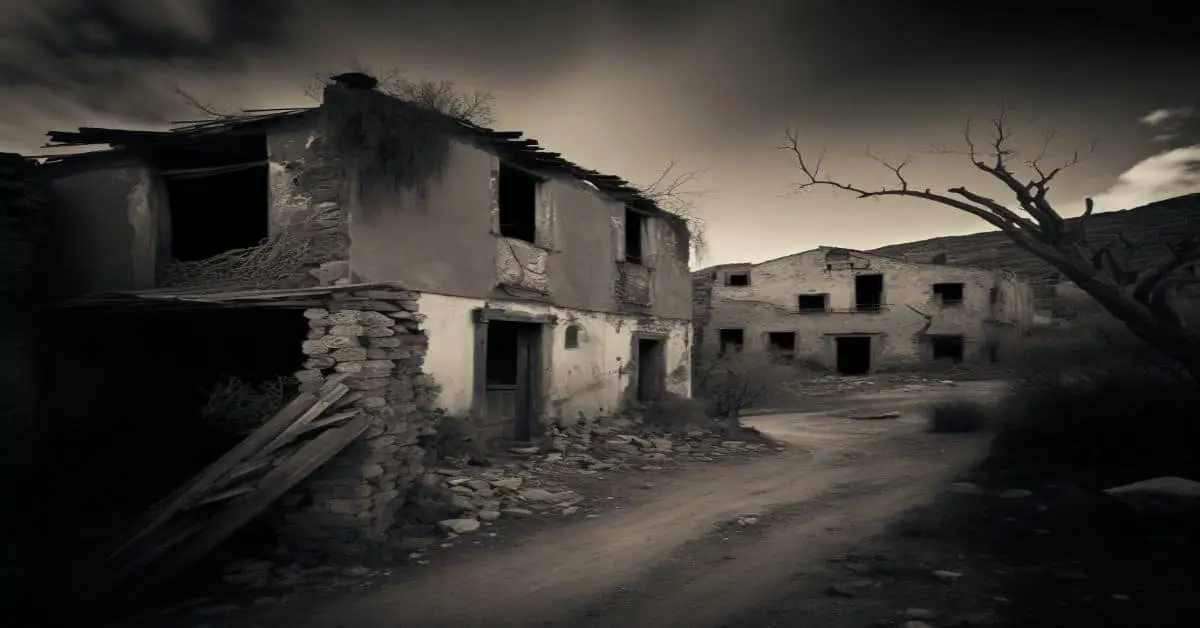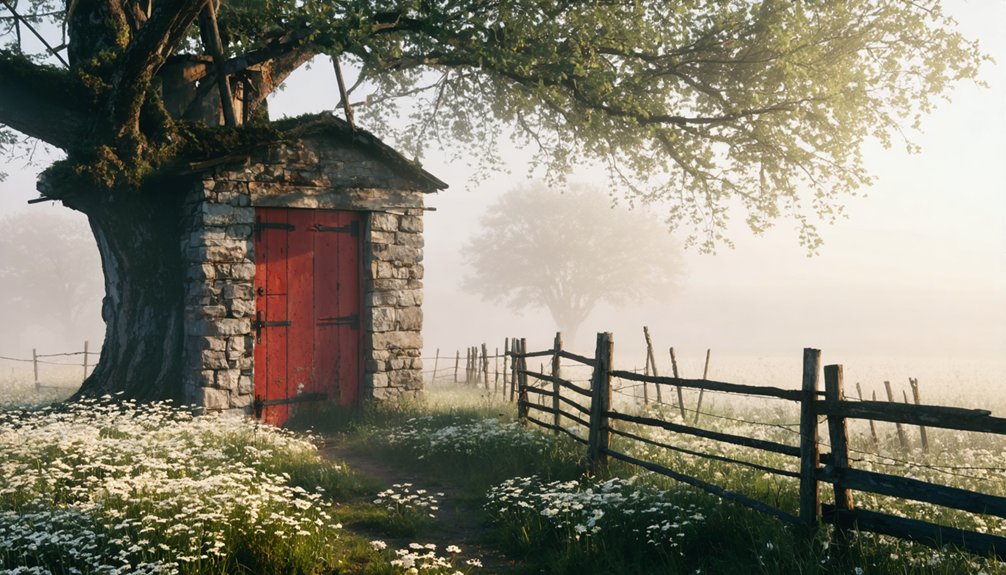You’ll find Dudley’s ghost town remains in the southeast corner of Allen Township, Polk County, Iowa, along the Des Moines River. Founded in 1846 by Jeremiah Church and John Griffin, this pioneer settlement struggled against devastating floods, including the Great Flood of 1851. The town’s population peaked at 64 residents in 1925 before declining to just 12, with only a weathered population sign marking its existence today. The river settlement’s forgotten tales await in Iowa’s rich historical records.
Key Takeaways
- Dudley was established in 1846 by Jeremiah Church and John Griffin along the Des Moines River in Allen Township, Polk County.
- The town’s population peaked at 64 residents in 1925 before declining to just 12 people in its final years.
- Flooding problems, including the Great Flood of 1851, forced relocation and contributed significantly to the town’s eventual abandonment.
- The community maintained a post office from 1908 to 1920 and relied primarily on small-scale farming for economic survival.
- No original structures remain today, with the former townsite completely reclaimed by Iowa’s agricultural landscape.
Historical Location and Geography
Located in the southeast corner of Allen Township in Polk County, Iowa, Dudley once stood as a promising settlement along the banks of the Des Moines River.
You’ll find this ghost town‘s historical footprint in an area that proved both advantageous and treacherous for its early inhabitants.
The river’s influence shaped every aspect of Dudley’s brief existence, from its initial establishment to its ultimate demise.
While the waterway provided essential transportation and resources, it also brought devastating flooding impact that would seal the town’s fate.
Much like the town of Dudley, England which was named an unhealthy place in 1851, this Iowa settlement faced significant environmental challenges.
Historical maps from the 1850s show Dudley as a settlement of significance, but its position in flood-prone terrain proved unsustainable.
The topography that initially attracted settlers to this location ultimately contributed to its abandonment, leaving behind only memories of a once-thriving riverside community.
Today, like the Dudley in Wapello County, this location maintains a very small population of scattered rural residents.
Early Settlement and Development
The settlement of Dudley began taking shape in February 1846 when Jeremiah Church and John Griffin established the town near the Des Moines River. They chose a location at Keokuk’s Bend, roughly three miles east of present-day Carlisle, though this decision would later prove problematic.
The early inhabitants faced significant settlement challenges, most significantly the devastating Great Flood of 1851. This natural disaster forced the community to abandon their original location and relocate. Like the residents of Dark Entry Forest, the area has been reclaimed by nature, leaving little evidence of its past.
While Dudley held some importance in the 1850s, it maintained a relatively small population throughout its existence. The town’s vulnerability to flooding ultimately led to its demise, with residents eventually establishing the new town of Carlisle. After the relocation, Jeremiah Church surveyed the new settlement that same year.
Today, you’ll find no trace of the original Dudley settlement at Keokuk’s Bend.
Economic Activities and Trade
Despite its initial promise as a settlement, Dudley maintained only modest economic activity throughout its brief existence. The town’s economy centered primarily around small-scale farming, with local barter likely serving as the main form of trade due to its isolation and lack of formal markets.
You’ll find evidence of Dudley’s limited economic reach in these key indicators:
- Population dropped from 55 residents in 1902 to just 12 in later years
- Post office operated only between 1908-1920, showing brief formal commerce
- No documented mills, mines, or manufacturing facilities existed
Agricultural challenges and limited transportation networks ultimately hindered Dudley’s growth. Much like the struggles faced in Dudleytown, Connecticut, where poor resources and harsh winters devastated local farming efforts, Dudley’s isolation proved insurmountable. The region suffered from infertile soil similar to Dudleytown’s agricultural difficulties.
Without rail connections or established trade routes, farmers struggled to reach broader markets, leading to the town’s eventual economic collapse and abandonment.
Life in Pioneer Dudley
As you walk through pioneer Dudley’s history, you’ll find daily life centered around the Des Moines River, where residents relied on river trade for essential supplies and communication with other settlements.
Like many frontier settlements of the era, Dudley saw rapid population growth as Iowa’s total inhabitants increased from just over 10,000 in 1836 to more than 43,000 by 1840.
The community’s gathering spots, though not extensively documented, would have included the basic infrastructure laid out by Jeremiah Church in the original town plat. Similar to how the early Dudley Township settlers made long trips for milling and supplies, these pioneers had to overcome significant transportation challenges.
Your glimpse into pioneer life reveals a settlement vulnerable to nature’s whims, as demonstrated by the devastating 1851 flood that ultimately forced residents to abandon the original location.
Daily Pioneer Activities
Living along the Des Moines River in Dudley during the mid-1800s meant daily activities revolved around survival and self-sufficiency.
As a pioneer, you’d spend your days engaged in essential chores that followed the natural rhythms of the seasons, from planting crops in spring to harvesting before winter’s arrival.
Your daily routines would have included:
- Farming tasks using manual tools to work the fertile valley soil, growing staples like wheat.
- Gathering resources from the surrounding area, including wood for fuel and construction.
- Trading or bartering with neighbors for necessities you couldn’t produce yourself.
The proximity to the Des Moines River shaped these activities, providing water access but also presenting challenges during floods like the devastating one in 1851.
The settlers’ agricultural efforts proved highly successful, with many establishing profitable farms that produced abundant crops of corn, wheat, and vegetables.
River Trade Importance
While settlers faced numerous hardships in pioneer Dudley, the Des Moines River served as their essential lifeline for trade and commerce in the mid-1800s.
You’d find the river bustling with activity as locals utilized it for transporting agricultural products and receiving essential supplies. The river commerce faced significant challenges, though – freezing winters halted navigation, and the lack of steamboats meant heavy reliance on teamsters who often demanded steep fees.
Trade routes weren’t always reliable, with risks ranging from theft to challenging encounters with Native American tribes. Despite these obstacles, the Des Moines River’s presence spurred industrial growth, supporting the development of lumber and flour mills. Much like how security checks protect modern digital commerce, local militias worked to ensure the safety of river trade routes.
In 1848, the construction of locks and dams began, reflecting the community’s determination to enhance river navigation and expand trade possibilities.
Community Gathering Places
Pioneer Dudley’s social fabric centered around several key gathering places that shaped daily life in the settlement. You’d find social interactions happening daily at the general store and post office, where residents exchanged news while picking up supplies and mail. These multifunctional spaces became essential hubs for maintaining community bonds.
The town’s communal activities revolved around three primary venues:
- The local schoolhouse, which hosted educational, political, and cultural gatherings
- Church buildings, serving both religious services and community events
- Outdoor spaces like the town green, where celebrations and public announcements took place
With only 55-64 residents, Dudley’s gathering spots reflected the tight-knit nature of pioneer life, where buildings often served multiple purposes to maximize their utility for the small population.
The Town’s Decline
Despite showing modest growth in the early 1900s, with its population increasing from 55 residents in 1902 to 64 by 1925, Dudley’s development stalled completely by 1940.
This population stagnation marked the beginning of the town’s steady decline. You’ll find that Dudley’s fate was sealed by several factors, including its diminishing transportation relevance as regional development shifted focus to larger nearby communities.
The closure of the local post office, which had operated through the 1920s, dealt a significant blow to the town’s viability. As agricultural mechanization reduced the need for rural labor and urban areas drew residents away, Dudley gradually lost its essential services and infrastructure.
The town’s decline mirrored the pattern of many small Iowa communities that couldn’t adapt to changing economic realities.
Mysterious Tales and Local Legends
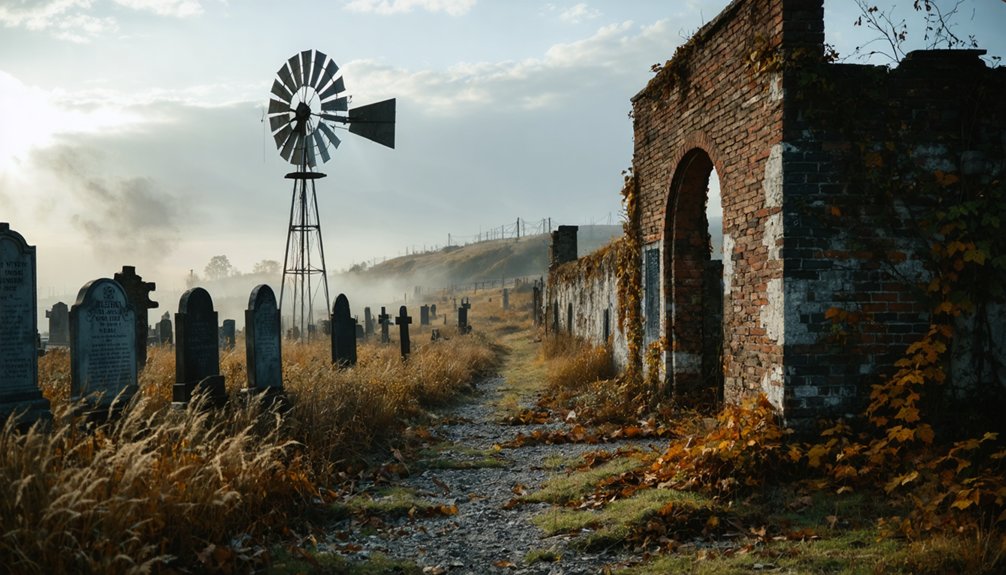
Since its abandonment, Dudley’s wooded remnants have become steeped in supernatural lore and unexplained phenomena. You’ll find ghostly encounters reported throughout the area’s dense forest, where visitors claim to experience eerie phenomena that defy explanation.
Abandoned decades ago, Dudley’s dark woods harbor countless ghostly tales and strange occurrences that continue to mystify visitors.
Local legends tell of three distinct supernatural patterns:
- Shadowy figures emerge from old cellar remains, often pursuing unsuspecting visitors through the trees.
- Strange glowing creatures appear in the woods, accompanied by unexplained whispers and voices.
- An overwhelming sense of being watched pervades the area, with many reporting feelings of dread and suffocation.
The land’s mysterious history connects to Native American sacred grounds, and some believe a generational curse plagues the region.
While historians dispute these claims, the unexplained disappearances and high rate of tragic incidents continue to fuel speculation about supernatural forces at work.
Physical Remnants Today
Today in northwest Wapello County, you’ll find little evidence that Dudley ever existed as a thriving community. The former townsite has been completely reclaimed by Iowa’s agricultural landscape, with crops and pastures stretching across what were once streets and homesteads.
You won’t spot any original structures, foundations, or ruins – not even a single wall remains standing to mark where buildings once stood.
Site accessibility is limited to rural dirt and gravel roads, typical of Iowa’s countryside. The only hint of Dudley’s existence is a weathered population sign that humorously declares “Population 12 and God only knows how many dogs and cats.”
The land’s current agricultural use mirrors its surroundings, making it nearly impossible to distinguish where this once-populated town began or ended.
Legacy and Historical Significance
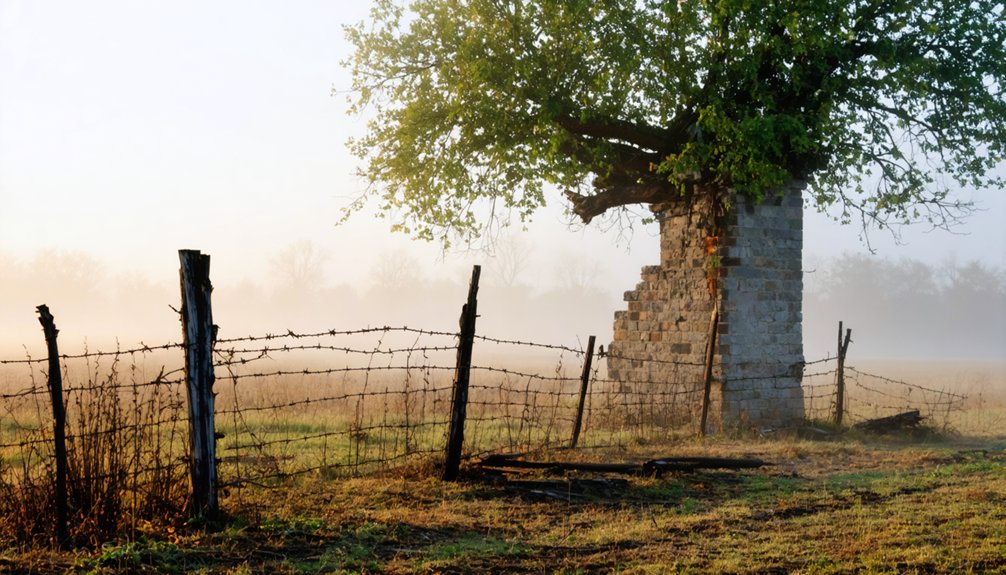
While physical traces of Dudley have vanished, its historical footprint remains embedded in Iowa’s settlement narrative.
Today, you’ll find its cultural heritage preserved through historical documentation and local memory, particularly its role as a Des Moines River settlement in 1850s Allen Township.
Along the Des Moines River, Dudley’s legacy lives on through preserved records and stories of its 1850s Allen Township origins.
For those interested in historical preservation, Dudley’s story reveals significant patterns:
- Population stability from 1902-1940 (55-64 residents) before eventual abandonment
- Post office operations connecting Dudley to surrounding communities like Elkhart
- Economic shifts reflecting broader changes in transportation and commerce
You can trace Dudley’s influence in county archives, ghost town registries, and genealogical records, where it continues to inform researchers about Iowa’s rural development patterns and the complex dynamics of small-town life in America’s heartland.
Frequently Asked Questions
Were Any Notable Crimes or Murders Reported in Dudley During Its Existence?
You won’t find any documented unsolved mysteries or criminal history for this location. Available records don’t show notable crimes or murders occurring during the town’s brief, sparsely populated existence.
Did Native American Tribes Have Settlements in the Dudley Area Before Pioneers?
Archaeological evidence shows that over 17 tribes inhabited Iowa. You’ll find that Native American settlements, particularly from Meskwaki and Iowa tribes, existed along the Des Moines River near Dudley’s future location.
What Natural Disasters or Epidemics Affected Dudley’s Population?
You’ll find limited historical records detailing specific flooding events or disease outbreaks, though Dudley’s location near the Des Moines River likely made it vulnerable to periodic floods and waterborne illnesses.
How Did Dudley Residents Celebrate Holidays and Conduct Social Gatherings?
Under twinkling lantern light, you’d find holiday traditions centered around the post office and river, with community gatherings featuring church services, harvest celebrations, patriotic Fourth of July picnics, and shared meals.
Were There Any Prominent Families or Individuals Who Influenced Dudley’s Development?
You won’t find records of prominent families or influential individuals who shaped Dudley’s development. The town’s brief existence and destruction by the 1851 flood left no documented legacy of notable residents.
References
- https://en.wikipedia.org/wiki/Dudley
- https://genealogytrails.com/iowa/polk/abandoned_towns.htm
- https://en.wikipedia.org/wiki/List_of_ghost_towns_in_Iowa
- https://pubs.lib.uiowa.edu/annals-of-iowa/article/id/13466/download/pdf/
- https://kids.kiddle.co/List_of_ghost_towns_in_Iowa
- https://pubs.lib.uiowa.edu/annals-of-iowa/article/id/13329/download/pdf/
- https://www.americanhauntingsink.com/dudleytown
- https://www.houseofhighways.com/usa/midwest/iowa/dudley
- https://en-academic.com/dic.nsf/enwiki/9223748https:/en-academic.com/dic.nsf/enwiki/227666
- https://latitude.to/articles-by-country/us/united-states/318608/dudley-iowa
